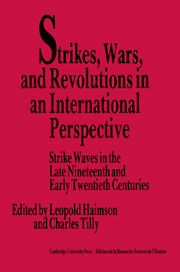 Strikes, Wars, and Revolutions in an International Perspective
Strikes, Wars, and Revolutions in an International Perspective Book contents
- Frontmatter
- Contents
- List of contributors
- Preface
- Part I Introductions
- Part II Models and realities
- Part III Workers in metal-processing enterprises in comparative perspective
- Part IV The effects of short-term variation
- 18 Introduction
- 19 Economic cycles and labor conflicts in Germany during the first quarter of the twentieth century
- 20 The crisis of state and society in Britain, 1917–1922
- 21 Strikes and the war
- 22 Labor unrest in Imperial Russia on the eve of the First World War: the roles of conjunctural phenomena, events, and individual and collective actors
- 23 Strikes in Russia, 1917: the impact of revolution
- Part V Conclusion
18 - Introduction
Published online by Cambridge University Press: 25 March 2010
- Frontmatter
- Contents
- List of contributors
- Preface
- Part I Introductions
- Part II Models and realities
- Part III Workers in metal-processing enterprises in comparative perspective
- Part IV The effects of short-term variation
- 18 Introduction
- 19 Economic cycles and labor conflicts in Germany during the first quarter of the twentieth century
- 20 The crisis of state and society in Britain, 1917–1922
- 21 Strikes and the war
- 22 Labor unrest in Imperial Russia on the eve of the First World War: the roles of conjunctural phenomena, events, and individual and collective actors
- 23 Strikes in Russia, 1917: the impact of revolution
- Part V Conclusion
Summary
Industrial conflict is volatile
The temporal patterns of strikes do not resemble those of births, or school attendance, or traffic accidents. Births, school attendance, traffic accidents, and many other repetitive social phenomena display a kind of quantitative inertia: One year's pattern usually resembles the previous year's quite closely, and large changes only occur gradually.
Strikes differ emphatically from such cumulative social phenomena; they veer rapidly in location and number from one period to the next. To be sure, the frequency of strikes varies with the season in construction, schoolteaching, and a number of other trades that have annual production cycles. The periodicity of labor contracts affects the rhythm of industrial conflict. And to the extent that the business cycle follows a regular pattern – a much-disputed subject – so do the ebb and flow of strikes. Yet a glance at almost any national strike series shows large swings in frequency and amplitude from month to month and year to year. Indeed, strikes often arrive in great waves that wash over an entire region or country.
The volatility of strike activity resembles that of open political struggle. As represented by demonstrations, marches, meetings, petitions, partisan attacks, and related forms of contention, political struggles shift rapidly from pallid to intense, from small to immense. War, revolution, rebellion, and other forms of strategic interaction likewise swing quickly. When multiple parties struggle openly for advantage, volatility becomes the rule.
Why should that be? Three related features of strategic interaction contribute to its rapid variations in intensity.
- Type
- Chapter
- Information
- Strikes, Wars, and Revolutions in an International PerspectiveStrike Waves in the Late Nineteenth and Early Twentieth Centuries, pp. 433 - 448Publisher: Cambridge University PressPrint publication year: 1989
- 5
- Cited by


